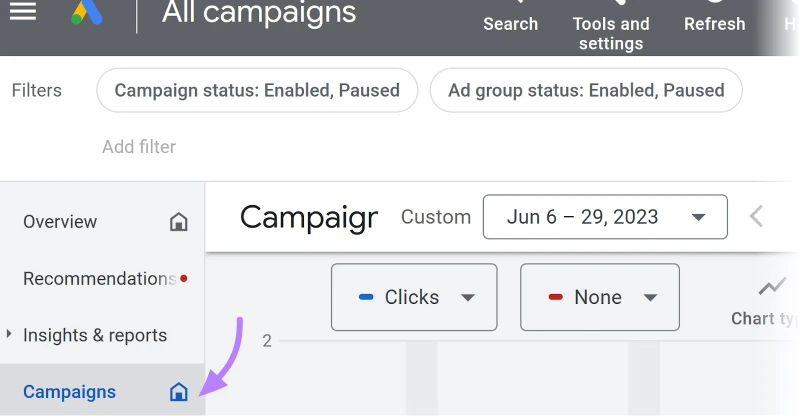Click Through Rate (CTR)
In the intricate dance of digital marketing and SEO, Click-Through Rate (CTR) is a vital metric, offering insights into the effectiveness of your content, ads, and links. More than a mere statistic, CTR offers deep insights into how your target audience is interacting with your brand online, serving as a compass for refining your digital strategies.
This exploration reveals how CTR can substantially enhance your SEO and digital marketing efforts, and how it can empower you to maximize the impact of both your SEO and pay-per-click (PPC) campaigns.
Demystifying the CTR Formula
Calculating CTR is a simple process:
CTR = (Total Clicks on Ad / Total Impressions) × 100%
So, if your ad or link gets 1,000 clicks from 10,000 impressions, the CTR would be 10%.
CTR = (1,000 / 10,000) × 100% = 10%.
The Impact of CTR in Internet Marketing

Audience Engagement:
High click-through rates on platfroms like Google Ads, indicate that your content is aligned with your target audience. This postively influences how the algorithm ranks and displays it, with each click postively impacting your CTR.
Cost Efficiency in PPC Advertising:
In PPC campaigns, a high CTR is vital. It not only signifies successful ad engagement but lowers the cost-per-click. This means you can drive more traffic to your website without increasing your ad spend, increasing conversion opportunities, and maximizing the return on investment (ROI).
Evaluating Campaign Effectiveness:
CTR is key for gauging the performance of specific ads, keywords, or campaigns. It allows you to understand what is resonating with your audience, providing insights that guide how you allocate your advertising budget, improve your marketing efforts and make adjustements to your content.
SERP Standing:
A robust CTR contributes to better search engine rankings. High engagement leads to a virtuous cycle where content that users find relevant is given prominence, reinforcing the importance of quality content and SEO optimization.
Enhancing Digital Strategy with CTR:
CTR serves as a broad indicator of your digital strategy’s effectiveness. It informs strategic decisions about content creation, ad placement, and can signal when a pivot in strategy might be needed.
CTR as a User Experience Indicator:
A high CTR often stems from an excellent user experience. A user-centric website design with clear calls-to-action and effortless navigation can significantly uplift CTR, highlighting the importance of an intuitive and accessible web design.
Finding Your CTR in Google Ads

To find your CTR in Google Ads:
Log into your Google Ads account.
Click on “Campaigns” on the left side.
Choose the campaign you’re interested in.
Look for the CTR in the statistics table. If it’s not visible, click on the columns icon, select “Modify columns,” and add CTR.
Apply the changes to see your CTR.
Optimizing SERP Elements to Enhance Click-Through Rate
Enhance your CTR by leveraging SERP features such as Featured Snippets, Rich Snippets, top ad placements, Local Packs, and Knowledge Graphs. Each plays a distinct role in how prominently your content is displayed and can dramatically influence user click behavior.
Featured Snippets and Rich Snippets: enhance visibility by providing quick answers or additional information right on the SERP, potentially increasing CTR for the featured site.
Ad placements at the top of SERPs can attract immediate attention, potentially improving CTR.
Local Packs or Maps listings significantly boost CTR for local businesses. The higher a site ranks in organic search results, the better its CTR.
Knowledge Graphs provide quick, authoritative snapshots and can direct significant traffic through increased CTR.
Differences in CTR trends between mobile and desktop searches are also crucial, owing to varying screen sizes and user behavior.
Benchmarking Good CTR
A ‘good’ CTR is contingent on industry standards, market conditions, and campaign specifics. In Google Ads campaigns, a high CTR can lead to an improved Quality Score, thus enhancing ad rank and and overall campaign success.
Is a High CTR Good or Bad?
Generally, a high CTR is considered beneficial. It signifies that your ad or link is relevant and appealing to users, leading to more clicks. However, it’s crucial to balance a high CTR with other metrics like conversion rate, ensuring that clicks lead to the desired action, such as sales or sign-ups.
How Do I Calculate Click-Through Rate?
CTR is calculated by dividing the number of clicks on an ad or link by the total number of impressions it receives, then multiplying the result by 100 to get a percentage. For example, if an ad receives 200 clicks out of 2,000 impressions, the CTR is 10%.
What is the Difference Between CTR and Click-Through Rate?
There is no difference between CTR and click-through rate; they are the same metric. CTR is simply the abbreviation for click-through rate.
Understanding CTR in the Context of Online Ad Campaigns
In the realm of PPC ads and online ad campaigns, CTR plays a vital role in evaluating the performance of ads on search engines. A higher CTR indicates that your PPC ad or search ad is effectively capturing the target audience’s attention, which can lead to improved ad positions and better campaign outcomes.
Adjusting Strategies for Optimized CTR
To optimize CTR, consider revising your ad copy, improving landing page relevance, and refining your target audience segmentation. Regularly reviewing and adjusting these elements can lead to a higher click-through rate and better campaign performance.
CTR and Its Role in Future Campaigns
Understanding the factors that influence CTR, such as the choice of keywords, ad relevance, and user intent, is crucial for future campaigns. This knowledge allows advertisers to craft more effective strategies, aiming for a higher CTR and better engagement with their target audience.
CTR as a Measure of Success
In summary, CTR is a key performance indicator in digital marketing, especially in the context of PPC campaigns, search ads, and online advertising. A good click-through rate varies by industry but is generally seen as a sign of campaign health and user interest. By continuously monitoring and optimizing CTR, businesses can enhance their online marketing efforts, ensuring their ads resonate with users and drive successful outcomes.

Written by Peter Selmeczy
As the Head of Growth at AutoSEO I love everything about content, SEO, and AI. Hope you like my musings and would love to talk to you in the comments.



